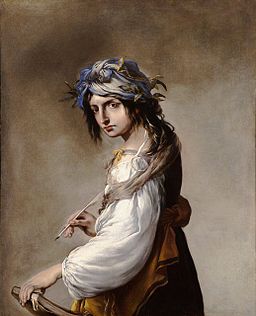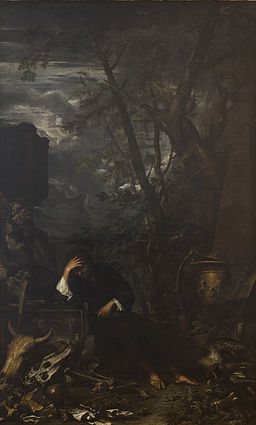
Lucrezia as Poetry, ca.1641
Born on July 21, 1615, Salvator Rosa was an Italian Baroque painter from Arenella, near Naples. Rosa is one of the only artists from the era to have had an influence on the Romantic artists, namely Turner, for his emotionally charged landscapes and highly independent attitude of being an artist, often rejecting lucrative commissions and only painting "my brushes when I am in ecstasy". An accomplished poet, he wrote many satires and was highly cynical in matters of the heart and marriage, quoted as saying that Un buon cavallo e una bella donna sono due care bestie— a good horse and a beautiful woman are two dear beasts.
This painting above of his wife, Lucrezia shows a stylized yet perceptive manner of portraiture. Judging by her appearance she was younger than him by more than a few years. This image here from Wikipedia is not the best for detail but it illustrates Rosa's understanding of body language and facial expression.

Astraias' Farewell to the Shepards, ca.1645
Here in the landscape is where Rosa shines. Look at the warm earth tones of the home with the dramatic curve of the tree in the foreground contrasts with the light blue of the background sky. Rosa has a style that is reminiscent of Tiepolo, but an earthier, Napolitano style.

Grotto with Cascades, ca.1640
A astonishing landscape, Rosa conjures a capricious dream-like world of chiaroscuro and nature. It is not difficult to see how the Romantics were inspired here. A simple palette of warm yellows and greens with deep shadows, Rosa demonstrates that less is definitely more when you paint from the heart.

Democritis, Absorbed in Thought, ca. 1651
This has the flavor and feel of a Renaissance era, like a dark Giorgione yet with a smoky atmosphere, lost in clutter and thought. Rosa heightens the claustrophobia with a dominant vertical composition, and dark muted tones except for the yellows of the urn and cowskull. Considered by many to be the father of science, here Rosa depicts him in chaos, a very dark interpretation of a brilliant mind in the ancient world.

The ghost of Samuel appearing to Saul in the Witch of Endor, ca.1668
Rosa's golden light returns here in a scene that is more reminiscent of a fantasy novel than a Baroque painting, and I am not certain of the history behind this work at all. I love the contrast of action with stillness here. Rosa demonstrates superb skill as story teller and painter with deft ease.

Landscape with Tobit and the Angel, ca.1670
The chiaroscuro of Rosa comes to life here once again. The towering clouds in the background heighten the drama. The angled tree to the left is touched by warm sunlight, as is the edge of the mountain off to the right. Rosa creates his world from a subconscious, deep, dark and surreal...and ahead of his time.
Comments
Post a Comment